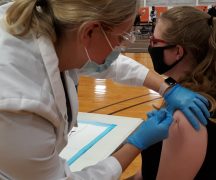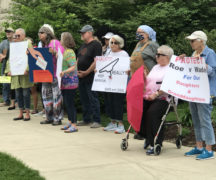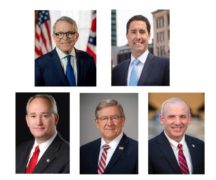A statue of a large steer greets visitors to the Pickaway County Fairgrounds, and this year, signs with cows on them could be seen at the entrance of each animal barn.
The signs read: “Maintain social distancing. Keep one cow apart. Protect against infection.”
Reminders of the coronavirus pandemic were everywhere at the first county fair held in Ohio this year, which wrapped up this past weekend. When I bought my ticket Friday afternoon, the man inside the entrance booth started to hand me my change, then stopped, remembering the safety protocol.
“Oh, do you answer yes to any of the questions on that sign?” he asked, pulling the money back.
The sign asked if I had been experiencing any common symptoms or had been recently exposed to someone with the virus. I told the man I was good to go, and he cheerfully reached back out with the money.

The fairgrounds were renovated just last year. As someone who’s covered my fair share of fairs, I was suitably impressed. But Friday was a scorcher, so I relied on an old reporting trick from my days in Vinton County. When the heat gets unbearable or the rains fall, I head to the Fair Board office to soak in some air conditioning and make small talk with local organizers.
Vinton County was among the first counties to cancel its 2020 fair, typically held in July. Many other counties followed suit throughout the unsteady spring months, back when the virus impact was still in doubt and there was no assurance from the state that fairs would even be allowed to be held.
Some counties chose to plan a scaled-down fair, cutting back on items like entertainment acts which draw crowds of people into confined grandstands.
The earliest fair on this year’s schedule, Paulding County in Northwest Ohio, decided to cancel and return in 2021. Next up was Pickaway County. All spring, organizers held out hope they would be able to put on a “full fair.”
Then in early June, Gov. Mike DeWine gave fair boards the green light to host whatever fair they felt comfortable having — provided they follow a number of outlined safety measures. The state even offered each county up to $50,000 in grant funding to pay for the expense of hosting a fair with these mitigations.
That was welcome news for the Pickaway County Agricultural Society, which scurried to prepare the grounds for a June 22 opening ceremony. Speaking during that ceremony, the group’s president, Von Cremeans, said he was glad organizers did not have to fall back on a “Plan B.”

sought all along to host a “full fair”
for the benefit of local kids.
“It’s been a challenging winter, but I’m just glad we’re all here and not trying to show our animals on Zoom,” Cremeans said, eliciting laughter inside Heritage Hall.
“There’s so many people that helped us get through this,” he continued. “We sat and we planned for hours upon hours to make sure the kids got what they wanted: It was to show their animals and come to the fair.”
Cremeans stressed the importance of following new COVID-19 guidelines for the week to come. With Pickaway County being the first fair, Cremeans said he wanted to provide a good example so that other fairs would be able to have the same opportunity.
The fair’s fourth day was a bad day for coronavirus statistics in Ohio. A total of 892 new cases were reported to the Ohio Department of Health in the preceding 24 hours, the most in one day since April.
Pickaway County has reported more than 2,000 cumulative cases, with 64 hospitalizations and 41 deaths. Most of these cases are attributed to the Pickaway Correctional Institution a few miles north of Circleville. The state has reported 35 inmate deaths, nearly 200 inmates in quarantine and another 1,500 that have tested positive for the virus and since recovered.
The recent uptick in cases here in Ohio and elsewhere troubled a woman hawking cotton candy on the midway, who told me she’d spent the morning reading about coronavirus news.
“I think they’re going to shut things back down,” she said.
This has been a rough 2020 for traveling food vendors, which rely on a busy slate of festivals and fairs during the warmer months. Many of the community festivals of spring were canceled this year, from the Feast of the Flowering Moon in Chillicothe to the Sugar Maple Festival in Bellbrook.
There have been some efforts around the state to provide “drive-thru food fairs,” with vendors setting up at fairgrounds to give Ohioans a taste of corn dogs and snow cones.
But the real action is at week-long fairs, and things aren’t looking any more promising in the months ahead. A schedule of summer 2020 festivals is plastered with “CANCELED” designations. The cotton candy vendor I talked to said all of the Fourth of July celebrations were wiped out. After Pickaway County, the stand had no other events planned until August.
Safety at the fair
Just as the state hoped, there were mitigation steps taken all over the fairgrounds. Hand sanitizer and handwashing stations were plenty. A regular public service announcement urged fairgoers to wash their hands and stay socially distant. Inside the animal barns, each row of cages had an arrow telling you which way to walk, just like a grocery store.

to head “one way” down the row of animals.
While other fairs are not planning to have games and rides this year, Pickaway County had both. One such attraction featured a carnival-esque walk-through, with fun mirrors and spinning floors and the like. This meant lots of touching around for kids inside. At the entrance was a bottle of hand sanitizer, with a sign reading, “thank you for helping prevent the spread of germs.”
Following state restrictions, the fair allowed only a 50% occupancy to the grandstand for events like the tractor pull and rodeo.
The fair encouraged masks, but I saw very few people wearing them besides those working at food stands and rides.
This didn’t seem so troubling outside, where the state-of-the-art fairgrounds kept everyone mostly spread apart. The animal shows held inside Heritage Hall were a different story. Dozens of spectators watched shoulder-to-shoulder in the stands.
The fair did offer a safe option for those not wanting to attend those shows: All events were livestreamed on Facebook.
This year marked the 75th anniversary of the Pickaway County Fair. Several 4-H groups, already prone to lavish displays of creativity and flourish, celebrated the occasion with elaborate club booths. The Darby Fine and Dandy Club, named for the small village of Darbyville, also celebrated its 75th year in 2020. The booth showcased stuffed animals adorned with birthday hats and club enrollment forms dating back to the late 1940s.
There were also photos taken in the past year of 4-H’ers volunteering at blood drives and community food giveaways. Taped to the poster board were thank you notes written to businesses which had purchased animals at last year’s livestock sale.
Above a collage of members’ smiling faces was the caption, “This is what 4-H looks like.”
Hanging around the fair on Friday afternoon, I heard little discussion of the pandemic still gripping a nation that has lost more than 125,000 Americans to the virus. It’s been a long few months, and this fair offered residents a chance to get away from the debates about masks and the never-ending politicization of the contagious disease.

celebrated the event’s 75th anniversary.
Well, I did see one politician who strode around the pavilion. He’d “traveled” to Circleville all the way from Illinois, speaking about the election … of 1864, not 2020. An Abraham Lincoln impersonator tipped his top hat to those he passed, taking photographs with curious, but amused children.
Two other gentlemen entertained those on the pavilion. A father and son magician duo who perform by the name of “The Almost Amazing Rex and Dana” had just finished up a set at the amphitheater. As they walked by, a family that had seen the show asked about one of their tricks.
“Hey,” a man called out to Rex and Dana, “you turned $1s into $100s. Can you turn $5s into $500s?”
“Well,” Dana answered, “the $1s are just a warm-up.”
The magicians delivered an impromptu show at the family’s table. They replicated the trick, with Dana turning Washingtons into Benjamins.
He handed a woman one of the $100 bills.
“Usually at the shows, we give a $100 (bill) away,” he said, then snatching the money back. “Unfortunately, only at our shows.”
Then they rattled off a few quick-hit card tricks. The family was thoroughly entertained, laughing along with each illusion.
It’s a testament to the weirdness of 2020 that a close-up magic show, with dollar bills transforming and cards disappearing, felt almost normal. Even just for a few minutes.
Then the magicians packed up and left. Over the public address system came a warning to keep our hands clean.
During a pandemic, you can only escape reality for so long.

performed magic tricks at the fair.
Shortly after I left the fairgrounds, Friday’s virus statistics were publicized. These were even worse than the day before. The state reported 987 new cases, the largest one-day total Ohio had seen besides when mass testing was conducted at prisons like Pickaway Correctional.
We’re now living in a paradox. Cases, hospitalizations and deaths are still rising precipitously, all while society attempts to carry on with public events — with warning signs and hand sanitizers and all.
“It’s not normal. Nothing is normal,” an organizer inside the Fair Board office told me, describing a week-long fair held during a pandemic.
Yet, just a few hundred feet away from the office were games, rides, families, laughter.
DeWine and other public officials continue to implore Ohioans to take the virus seriously. Meanwhile, with the weather warm and patience growing thin, many are returning to a more comfortable sense of normalcy. Of cotton candy, of traditions, of community.
As I headed drove back up Route 23, I kept thinking back to the poster of magicians Rex and Dana resting on the pavilion. It included a motto of Rex’s, the father of the duo.
“If you can’t have fun, you might as well stay home.”





